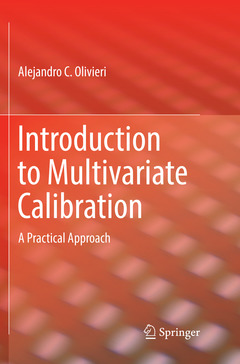Introduction to Multivariate Calibration, 1st ed. 2018 A Practical Approach
Auteur : Olivieri Alejandro C.

1.1. Chemometrics: what's in a name?
1.2. Univariate and multivariate calibration
1.3. The order and the ways
1.4. Why multivariate calibration?
1.5. Near infrared spectroscopy: the analytical dream
1.6. Multi-way calibration and new advantages
1.7. References
2. First-order multivariate models: CLS
2.1. Direct and inverse models
2.2. Classical least-squares
2.3. The CLS calibration phase
2.4. Why least-squares? Mathematical requirements
2.5. The CLS prediction phase
2.6. The CLS vector of regression coefficients
2.7. A CLS algorithm
2.8. Validation of the CLS model2.9. Spectral residuals and sample diagnostic
2.10. The first-order advantage
2.11. A real case
2.12. Advantages and limitations of CLS
2.13. Exercises
2.13. References
3. First-order multivariate models: ILS
3.1. Why calibrating the other way around? A fantastic idea
3.2. The ILS calibration phase
3.3. Mathematical requirements
3.4. The ILS prediction phase
3.5. An ILS algorithm
3.6. The validation of the ILS model
3.7. Advantages and limitations of ILS
3.8. The successive projections algorithm
3.9. A real case3.10. How to improve ILS
3.11. Exercises
3.12. References
4. Principal component analysis: PCA
4.1. Why compressing the data?4.2. Real and latent variables
4.3. Principal components
4.4. Significant loadings and scores
4.5. Non-significant loadings and scores
4.6. Sample classification with PCA
4.7. Multivariate calibration with PCA
4.8. Exercises
4.9. References
5. First-order multivariate models: PCR
5.1. Combination of PCA and ILS: another fantastic idea
5.2. Matrix compression and decompression
5.3. The PCR calibration phase
5.4. Mathematical requirements
5.5. The PCR prediction phase
5.6. The PCR vector of regression coefficients
5.7. A PCR algorithm5.8. What is the value of A?
5.9. Advantages and limitations of PCR
5.10. A real case
5.11. What can be better than PCR?
5.12. Exercises
5.13. References
6. The optimum number of latent variables
6.1. The importance of estimating the optimum A
6.2. Explained variance
6.3. Visual inspection of loadings
6.4. Leave-one-out cross validation
6.5. Cross-validation statistics
6.6. Monte Carlo cross-validation
6.7. Other methods
6.8. The principle of parsimony
6.9. Beyond statistics: physicochemical interpretation of A6.10. Exercises
6.11. References
7. First-order multivariate models: PLS
7.1. The PLS philosophy
7.2. The PLS calibration phase
7.3. Mathematical requirements
7.4. The number of latent variables
7.5. The PLS prediction phase
7.6. The vector of PLS regression coefficients
7.7. A PLS algorithm7.8. Advantages and limitations of PLS
7.9. A real case
7.10. PLS-1 and PLS-2 models
7.11. Discriminant PLS
7.12. Beyond PLS
7.12. Exercises7.13. References
8. Comparison of models
8.1. Which is the best model?
8.2. The randomization test
8.3. How the test works
8.4. Algorithm for the randomization test
8.5. PCR, PLS-1 and PLS-2: when, how and why
8.6. Linear and non-linear models: when, how and why
8.7. Tests of multivariate non-linearity
8.8. A real case8.9. Conclusions
8.10. References
9. Data pre-processing
9.1. Selection of calibration samples
9.2. Calibration outliers9.3. Selection of wavelengths to build the model
9.4. The vector of regression coefficients as selector
9.5. Interval-PLS
9.6. A real case
9.7. Other selection methods
9.8. Mathematical transformation of spectra
9.9. Mean centering
9.10. Smoothing and derivatives: advantages and hazards
9.11. Multiplicative correction
9.12. Other pre-processing methods
9.13. How to choose the best pre-processing9.14. Is pre-processing always useful?
9.15. Real cases
9.16. A library of MATLAB codes
9.17. Exercises
9.18. References
10. Analytical figures of merit
10.1. Usefulness of figures of merit
10.2. Sensitivity
10.3. Selectivity
10.4. Prediction uncertainty
10.5. Effect of mathematical pre-processing
10.6. Detection limit
10.7. The blank leverage
10.8. Quantitation limit
10.9. Other figures of merit
10.10. A real case
10.11. References
11. MVC1: software for first-order multivariate calibration
11.1. Downloading and installing the software
11.2. General characteristics11.3. Example 1: determination of bromhexine in anti-cough syrups by UV-visible spectrophotometry
11.4. Example 2: determination of I5 in reaction mixtures by UV-visible spectrophotometry
11.5. Example 3: determination of moisture, fat, protein and starch in corn seeds
11.6. More examples
11.7. Other calibration models
11.8. Free and commercial software
11.9. References
12. Non-linearity and artificial neural networks
12.1. Linear and non-linear problems
12.2. Artificial neural networks
12.3. Radial basis functions
12.4. Neural networks in MVC1
12.5. A real case
12.6. References
Prof. Dr. Alejandro César Olivieri has obtained his B.Sc. in Industrial Chemistry from the Catholic Faculty of Chemistry and Engineering, Argentina, in 1982, and his Ph.D. from the Faculty of Biochemical and Pharmaceutical Sciences, University of Rosario, Argentina, in 1986. He currently works in the Department of Analytical Chemistry of the latter Faculty, and is a fellow of the National Research Council of Argentina (CONICET). He has published about 200 scientific papers in international journals, several books and book chapters and supervised ten Ph.D. theses. He was John Simon Guggenheim Memorial Foundation fellow (2001-2002). His primary research field is multivariate calibration, including first- and higher-order models, analytical figures of merit and software development.
Introduces difficult concepts in a qualitative way with minimal use of mathematics
Describes a freely available software for practical work
Includes both theoretical and practical exercises to illustrate the content
Highlights the latest advances in multivariate calibration models, mathematical pre-processing and analytical figures of merit
Includes supplementary material: sn.pub/extras
Date de parution : 12-2018
Ouvrage de 243 p.
15.5x23.5 cm
Date de parution : 09-2018
Ouvrage de 243 p.
15.5x23.5 cm
Thèmes d’Introduction to Multivariate Calibration :
Mots-clés :
Multivariate calibration; Partial least-squares regression; Analytical figures of merit; Software for multivariate models; Spectral pre-processing; Direct and inverse calibration models; MVC1 software; Chemometrics introduction; Multivariate calibration textbook; Guide to multivariate calibration; First-Order Multivariate Calibration



